Looking exclusively at profits and income... artisan products are miles ahead of everything else, to the point that not processing your produce, be it animal or plant based, is just throwing money away, aside from corner cases with Animal Husbandry wherein it actually makes sense to sell higher quality raw animal products.
However, this does require a substantial initial investment in production and processing, both in terms of where you are going to process and the actual processing machines themselves. As of 1.4, Sheds came into their own as far as what to use to process bulk products in for minimal footprint on your farm (assuming you aren't doing things like lining the bus tunnel, the quarry, and other areas where NPC's don't walk) with the inclusion of the Big Shed. But it still takes time and resources to ask Robin to build and upgrade them for you. Kegs and Preserves Jars aren't exactly cheap either, not in the quantities we're wanting if we truly wish to leverage the quantities that are possible. Many people handwave this, but I do want to address this as it will substantially impact how you think about production as early as your first spring.
First off, if cash is your goal, you're going to want mass kegs, full stop. Which means you need a lot of Oak Resin, which is the only true bottleneck in production, as everything else can at least in theory be purchased (even if at punitively expensive rates) from vendors in unlimited quantities, given access to sufficient capitol. And you're going to want it *fast*. You're going to want to start brewing Hops into Pale Ale in your first summer if you're really wanting to go gangbusters on profits, so you already need kegs down and ready to process by the time your first set of Hops comes up. This means planting a substantial number of oak trees, with tappers on all of them, as soon as you possibly can. See if you can get a stand of 30 oak trees planted by the end of the first week of first spring, if at all possible. That's a 5x6 grid, if you want a mostly squarish rectangle, but you can shuffles those numbers around if you need to fit whatever footprint best fits the location planned for the stand. It also means you need a heavy focus on mining (assuming you don't want to bankrupt yourself trying to buy ores from Clint) since 30 tappers is 60 copper ingots needed probably by the end of Spring at the latest. It's also 1,200 wood to sink into this infrastructure investment, which isn't insignificant at that point either.
Once having done that, you then need to keep up with the oak resin. After all, if we're going to look at oak resin as our bottleneck, we're going to want to maximize our usage of that resource, as soon as it comes up. Which means we're going to need to be making 30 kegs per week. That comes out to 30 copper bars, 30 iron bars, and 900 wood being consumed per week for the foreseeable future, as you ramp up your production to industrial scale.
Furthermore, sheds ain't cheap either, and you're going to want your shed *finished* before you start making kegs. So the moment you have your tappers down, you're going to want to drop in on Robin to get your first shed started. That's going to set you back 15,000g and 300 wood. That's after you've just sunk 1,200 wood and 60 copper bars into your tappers, and with the knowledge that you're going to need another 900 wood, 30 copper bars, and 30 iron bars before the week is out. But wait... there's more! There's only room for around 60ish (67 with optimal layout on PC, less if you cannot access corners due to being on a mobile device or platform) kegs per shed, which means you're going to need to repeat this every two weeks, in addition to whatever other building upgrades you want to 'keep up with the Joja's'. Or, if footprint is an issue, you're going to want to start considering upgrading your existing sheds to Big Sheds, which will set you back a cool 20,000g plus 550 wood and 300 stone per each upgrade. So it makes sense to defer costs as much as possible until your returns start coming in so you can afford a smooth and even growth curve, meaning you build sheds first, then upgrade them after you have the final number of sheds you plan on building on your farm. This takes careful planning and foresight, as well as a very strict economic rationing and budgeting policy.
And of course, the biggest problem with all this is that it is hitting you during the startup phase of your business model, when you are the most resource-constrained. Later on, of course, you'll be rolling in millions and able to buy just about anything, but much of this needs to go down before you can start reaping those numbers, which leads to some very interesting strategies right out of the gate. As the saying goes, if you fail to plan, you plan to fail.
In short: Artisan goods are the highest profit margin items, bar none. Items like Pale Ale, Ancient Wine, Starfruit Wine, and even Pomegranate and Peach Preserves simply dominate and crush the competition hands down. So if cash is your goal, it isn't if you should sell artisan goods, it's how quickly can you get set up to start making them. Because the sooner you can get your production infrastructure established, the soon you can rake in millions per season. So I don't think a discussion on maximizing profits can really be had without also discussing how to put yourself in a position to actually accomplish this goal.
